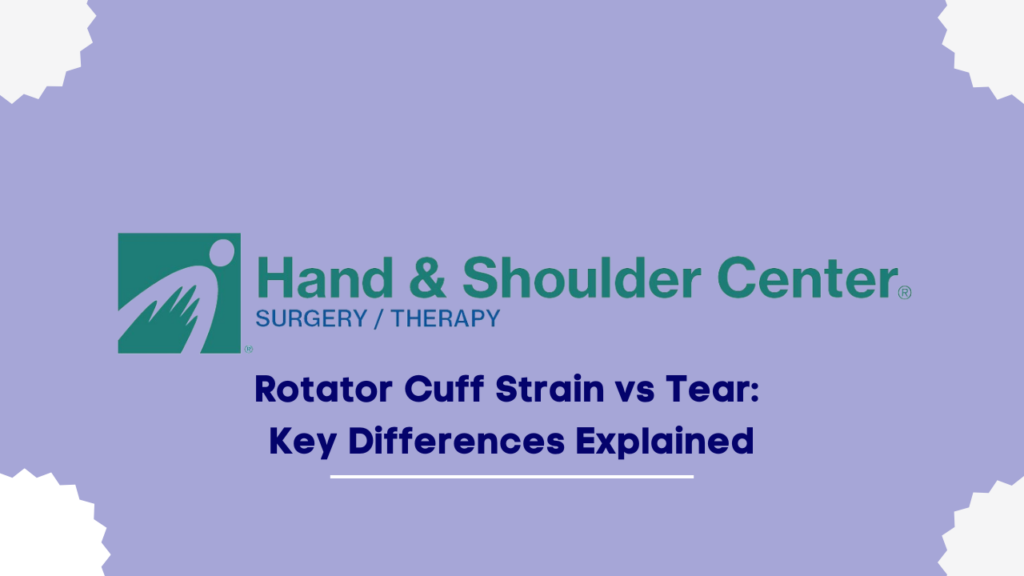Rotator Cuff Strain vs Tear: Key Differences Explained
If you’ve been experiencing shoulder pain, you may wonder if it’s a simple strain or something more serious like a rotator cuff tear. Understanding the difference between these two conditions—rotator cuff strain vs tear—can help you get the right care faster, preventing further injury.
What Is a Rotator Cuff?
First, let’s clarify: what is the rotator cuff? Your rotator cuff is a group of four muscles and tendons surrounding the shoulder joint. Its primary role is to stabilize your shoulder and assist in the various arm movements you perform daily.
Wondering where is your rotator cuff located? It wraps around the upper arm bone (humerus), connecting it to the shoulder blade. When healthy, it allows smooth movement. But when injured, it can significantly limit your daily activities.
Understanding Rotator Cuff Strain vs Tear
A common confusion among patients is the difference between a rotator cuff strain vs tear. While both conditions involve damage to the muscles or tendons, the severity and symptoms can differ significantly:
- Rotator Cuff Strain: This is a stretching or minor tearing of muscle fibers or tendons, typically caused by overuse or sudden awkward movements.
- Rotator Cuff Tear: A tear involves a complete or partial rupture of the tendon or muscle fibers, usually resulting from acute injury or chronic wear and tear.
Symptoms of a Rotator Cuff Strain
So, what does a strained rotator cuff feel like?
- Mild to moderate pain that worsens with certain arm movements.
- Soreness or stiffness, particularly after physical activity.
- Typically manageable pain that improves with rest and gentle stretching.
Symptoms of a Rotator Cuff Tear
Wondering what does a torn rotator cuff feel like? Here are two warning signs:
- Severe Pain: Persistent pain even at rest, which often disrupts sleep.
- Weakness: Difficulty lifting your arm overhead or performing simple daily tasks like combing your hair or reaching behind your back.
Other common symptoms include:
- A popping or clicking sensation during arm movement.
- Swelling and tenderness around the shoulder.
If you’re questioning how painful is a torn rotator cuff, it’s usually more intense and persistent compared to a strain. For a detailed guide on symptoms, visit our website at Hand & Shoulder Center.
How Do Rotator Cuff Tears Happen?
You might wonder, how does a rotator cuff tear happen? Rotator cuff tears usually result from:
- Sudden trauma, like a fall or lifting something heavy.
- Chronic degeneration from repetitive movements, common among athletes, manual laborers, or as part of the natural aging process.
Understanding what causes a torn rotator cuff helps in prevention and early intervention.
Diagnosing a Rotator Cuff Tear vs Strain
Wondering how to diagnose a rotator cuff tear? Diagnosis often involves a physical examination and imaging tests like an MRI or ultrasound.
Deltoid Strain vs Rotator Cuff Injury
Occasionally, patients confuse a deltoid strain with rotator cuff injuries. Deltoid strain vs rotator cuff injuries differ significantly:
- Deltoid strain usually results from a direct blow or intense lifting, with pain localized more superficially around the upper arm.
- Rotator cuff injuries typically involve deeper pain and more profound functional impairment.
If you’re unsure, visit Hand & Shoulder Center for professional evaluation.
Rotator Cuff Tendonitis vs Tear
Another area of confusion is distinguishing rotator cuff tendinitis vs tear. Tendonitis involves inflammation of the rotator cuff tendons, whereas a tear involves structural damage. The pain from tendonitis often eases with rest, while tear-related pain is persistent and often severe.
For a comprehensive list of symptoms and more details on these conditions, consider resources from reputable organizations like the American Academy of Orthopaedic Surgeons or WebMD.
Treatment Options: What Do They Do for a Torn Rotator Cuff?
Treatment varies significantly based on the severity of the injury:
- Strains and Mild Injuries: Rest, physical therapy, and anti-inflammatory medications are often sufficient.
- Severe Tears: Might require surgery, followed by rehabilitation.
It’s crucial to consult an expert to determine the best course of action tailored to your specific condition.
How to Know if You Need Professional Help
If you find yourself asking:
- How do I know if I tore my rotator cuff?
- How to tell if your rotator cuff is torn?
It’s advisable to seek professional guidance if you experience:
- Persistent pain lasting beyond a few days.
- Inability to perform everyday tasks comfortably.
Conclusion: Get Expert Care
Understanding the difference between rotator cuff strain vs tear is critical for receiving timely and appropriate treatment. Early diagnosis significantly improves recovery outcomes, helping you return swiftly to your active life.
For expert evaluation and compassionate care tailored to your needs, schedule a visit to Hand & Shoulder Center. Our dedicated specialists will guide you every step of the way, from diagnosis to recovery.

